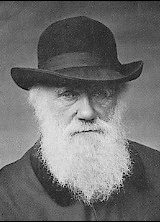Fossils and history
Fossils and history |
Related
interest: Origin of Species Evolution Main Page Tree of Life |
|
Early naturalists well understood the similarities and differences of living species leading Linnaeus to develop a hierarchical classification system still in use today. (17) It was Darwin and his contemporaries who first linked the hierarchical structure of the great tree of life in living organisms with the then very sparse fossil record. Darwin eloquently described a process of descent with modification, or evolution, whereby organisms either adapt to natural and changing environmental pressures, or they perish. I am initially constraining editorial boldness to the discussion page, because I think the two paragraphs that follow (offered without even my own copy editing) markedly expand the scope of the fossils page, which is my suggestion, but I worry about drifting too far a field. So, I look for feedback (concurrence and tomatoes) from what I think are several others dedicated to improving the page. I love the title “Developments in interpretation of the fossil record” that enables chronological storytelling. For references, I drew upon Knoll, Conway-Morris, Gould, Fortey and a couple of websites, all of which are enjoyable, non-recondite reading. I have also purposefully included keywords (e.g., tectonics; extinction events; Cambrian explosion) to facilitate page development.. Contemporary paleontology is too often thought of as the study of dinosaur bones because that is what captures the attention of the public and the news-reporting venues. The modern study of fossils actually has interdisciplinary linkages to many other scientific fields such as molecular biology, geochemistry, and evolutionary biology. The dinosaurs existed on an earth not greatly different than our own, and arguably their lineage is of relatively minor scientific importance. The preceding Paleozoic period was markedly different. It began with no terrestrial life, a highly oxygenated atmosphere, and with the progenitors for what would evolve to be the life forms we recognize today, as well as others that did not persist. Paleozoic fossils are testimony to an era of dramatic change to both earth and its life forms. The drama of the Paleozoic, beginning with the Cambrian Explosion exemplifies the coevolution of earth and life that has continued unabated since life appeared. “The evolutionary epic recorded by fossils reflects, as much as anything else, the continuing interplay between genetic possibility and ecological opportunity” (pg 5 of Knoll). The earth’s climate, tectonics, atmosphere, oceans, and periodic disasters invoke the primary selective pressures on all organisms to which they must adapt or perish. Many extinction events punctuate geological history, leaving environmental voids in which lineages appear and divide. The life forms, in turn, greatly affect earth’s environments. The fossil record encodes the inextricably linked coevolution of life and planet, albeit with diminishing clarity prior to the Cambrian where mostly microscopic life left meager fossil clues. Modern paleontology and evolutionary biology share a goal of unfolding the tree of life, which inevitably leads backwards in time to the microscopic life of the Precambrian when cell structure and functions evolved. Earth’s deep time in the Proterozoic and deeper still in the Archaean is only “recounted by microscopic fossils and subtle chemical signals”. During deep time, life only existed where it first appeared, in the sea, and most extant life yet exists in the sea. Even now “the land-based animals each carry with them a miniature ocean, pulsing in their cells and circulatory systems. All life, including human, could be viewed as containers of sea water with the same mineral constituency as the oceans and a dynamic dispersion of molecules that perform the biological processes that constitute life”. Molecular biologists, using phylogenetics, can compare DNA nucleotide and protein amino acid sequence similarity to infer taxonomy and evolutionary distances among organisms, but with limited statistical confidence. The study of fossils, on the other hand, can more specifically pin point when and in what organism branching occurred in the tree of life. Modern phylogenetics and paleontology act together to clarify sciences dim view of the appearance life and its evolution. http://www.ncbi.nlm.nih.gov/About/primer/phylo.html Charles Darwin was the first to recognize that the systematic hierarchy represented a rough approximation of evolutionary history. However, it was not until the 1950s that the German entomologist Willi Hennig proposed that systematics should reflect the known evolutionary history of lineages as closely as possible, an approach he called phylogenetic systematics. The followers of Hennig were disparagingly referred to as "cladists" by his opponents, because of the emphasis on recognizing only monophyletic groups, a group plus all of its descendents, or clades. However, the cladists quickly adopted that term as a helpful label, and nowadays, cladistic approaches to systematics are used routinely. * Monophyletic: two or more DNA sequences that are derived from a single common ancestral DNA sequence. * Clade: a group of monophyletic DNA sequences that make up all of the sequences included in the analysis that are descended from a particular common ancestral sequence. * Parsimony: an approach that decides between different tree topologies by identifying the one that involves the shortest evolutionary pathway. This is the pathway that requires the smallest number of nucleotide changes to go from the ancestral sequence, at the root of the tree, to all of the present-day sequences that have been compared. * Molecular Clock Hypothesis: states that nucleotide substitutions, or amino acid substitutions if proteins are being compared, occur at a constant rate, that is, the degree of difference between two sequences can be used to assign a date to the time at which their ancestral sequence diverged. The rate of molecular change differs among groups of organisms, among genes, and even among different parts of the same gene. Furthermore, molecular clocks require calibration with fossils to determine timing of origin of clades, and thus their accuracy is crucially dependent on the fossil record, or lack thereof, for the groups under study. Fossil DNA older than about 25,000–50,000 years is virtually empty of phylogenetic signal except in rare instances, and therefore traditional morphological studies of extinct and extant organisms remain a crucial component of phylogenetic analysis. The use of fossils in the phylogenetics of extant clades traditionally has been a contentious issue. Fossils usually are relatively incomplete, and their use commonly leads to an increase in the number of equally most parsimonious trees and a decrease in the resolution of phylogenies. Fossils alone, however, provide certain kinds of information about the biological history of a clade, and computer simulations have shown that even highly incomplete material can, under certain circumstances, increase the accuracy of a phylogeny, rather than decrease it. Examination of the fossil record allows us to: 1) make inferences about the nature of past environments, 2) reconstruct ancient biological communities, 3) estimate abundance of component species, 4) examine rates of evolutionary change and 5) understand the origin of the assemblage of extant organisms. However, the interpreting the fossil record is not trivial. Some species, due to structure and habitat, have outstanding fossil records, other species due to their structure or habitat may have a poor record. While a fossil can be very helpful in phylogenetic analysis, fossils are not required for phylogenetic reconstruction. Wiley, E.O., D. Siegel-Causey, D.R. Brooks, and V.A. Funk. 1991.
The Compleat Cladist: A Primer of Phylogenetic Procedures. The
University of Kansas Museum of Natural History, special publication
no. 19, Lawrence. Stratigraphic data have a role in phylogenetic analysis |
|||||||
Home
Geological Time Paleobiology Geological History Tree of Life
Fossil Sites Fossils Evolution Fossil Record Museum Fossils

 No
one knows when humans first discovered fossils, but we can be
fairly certain that proper interpretation in a non-superstitious,
scientific context did not begin until a few hundred years ago,
give or take several decades. The word fossil conjures in most
people an immediate image of a rock. Indeed, fossils are usually
rocks of sedimentary origin containing mineralized traces of past
organic life on earth. Viewed more broadly, fossils are a recorded
history of life on earth, or as Darwin put it, “a history
of the world imperfectly kept … only here and there a short
chapter has been preserved; and of each page only here and there
a few lines”.
No
one knows when humans first discovered fossils, but we can be
fairly certain that proper interpretation in a non-superstitious,
scientific context did not begin until a few hundred years ago,
give or take several decades. The word fossil conjures in most
people an immediate image of a rock. Indeed, fossils are usually
rocks of sedimentary origin containing mineralized traces of past
organic life on earth. Viewed more broadly, fossils are a recorded
history of life on earth, or as Darwin put it, “a history
of the world imperfectly kept … only here and there a short
chapter has been preserved; and of each page only here and there
a few lines”.